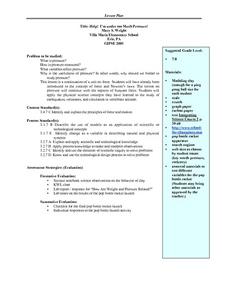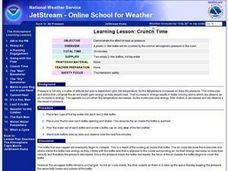Curated OER
Boyle's Law
In this Boyle's Law instructional activity, students respond to several short answer questions that pertain to Boyle's Law. They determine the volume of gas when pressure is increased and/or decreased. Students also determine what the...
Curated OER
Charles' Law
In this Charles' Law worksheet, students respond to several short answer questions as they pertain to Charles' Law. they calculate the decrease in temperature when it is compressed a specific amount. Students also determine the volume...
Curated OER
The Ideal Gas Equation
In this chemistry worksheet, students use the Ideal Gas Equation site by clicking on the New Question button and responding to the question that is presented in the box. From there they determine the value of their answer and enter it...
Curated OER
Help! I'm Under Too Much Pressure!
Students play with a ping pong ball sized piece of modeling clay observing what happens to the clay as they play with it and write their observations in their notebooks. They share the results of their observations introducing the term...
Curated OER
What is your lung?s capacity?
Students observe and determine what their lung capcity is. They fill a two-liter bottle completely with water and place the cap back on. Students fill a dishpan half full of water. They place the cap-end of the bottle into the water in...
Curated OER
The Hunt for Red October
Ninth graders identify and apply some of the vocabulary used in Science concerning the Sea Perch project. They view a video of The Hunt for Red October, and students make a comparative study of the translation of the printed work onto...
Curated OER
Pressure Versus Force: Landing On Ice!
Learners experiment with the relationship between pressure, force, and area. They determine the force and pressure exerted by a LC-130, which is commonly used for cargo and personnel transport in Antarctica.
Curated OER
Love Pressure Consequence
Students engage in a lesson that investigates the social problem of teen pregnancy and examines the role of peer pressure to being sexually active. They examine statistics to compare data according to different locations. Also students...
Curated OER
Sailing Through Bernoulli
Young scholars participate in a class discussion about Bernoulli's principle while looking at cross-sections of an airplane wing, and discussing the sail on a sailboat and the spoiler on a race car.
Curated OER
The Drag of Drag
Students are introduced to drag. Then they summarize drag by saying that the drag is proportional to the square of the velocity. Students then solve problems an example of such a problem: Explain why swimming underwater is faster than...
Curated OER
What Makes a Kite Fly?
Ninth graders compare the nature of forces of gravity, lift, thrust, and drag. They select proper materials for making a kite and attach a proper tail. Students interpret and summarize the observations made during the flight of the kites.
Curated OER
Relational Causality
Students explore volume and pressure. Through an activity, students discover what happens in situations when volume is increased but no additional air is able to enter the enclosed space. Students create models and explain their...
Curated OER
Ideal Gas Law
Students explain and use ideal gas law and use the law to solve problems. They use conversion factors to convert mass to mol. Also students use stoichiometry skills previously learned.
Curated OER
Learning Lesson: Go With the Flow
Students complete experiments with soda cans to examine the effect of pressure and air movement. They create low pressure and discuss its effects. They also examine thunderstorm safety rules.
Curated OER
Learning Lesson: Crunch Time
Students demonstrate the effect of heat on pressure. They use a 2-liter bottle and hot tap water to complete the experiments. They also discuss thunderstorm safety rules.
Curated OER
Learning Lesson: Measure the Pressure -- The "Wet" Barometer
Students use simple objects to create their own barometer. They have five days to build it and ten days to observe and collect data. They examine thunderstorm safety tips to end the lesson.
Curated OER
Learning Lesson: Measure the Pressure II -- The "Dry" Barometer
Learners use simple items to create their own aneroid barometer. They have five days to build it and ten days to observe and collect data. They examine tornado safety tips to end the lesson plan.
Curated OER
Metamorphic Sandwiches - - "Bread Rock"
Young scholars graphically show how metamorphic rock is formed by pressure and heat using bread.
Curated OER
Siphon Pump
Learners determine the basic types of pumps and how they work in terms of pressure, velocity, and elevation differences. They build two examples of gravity-driven water pumps.
Curated OER
Pumps
Students examine the basic types of pumps. They build a gravity-driven water pump and solve a mystery using their knowledge of pressures and pumps.
Curated OER
Wind Tunnel Aerodynamics Problem Set
Students, after reading an explanation from a NASA Web-based textbook, demonstrate an understanding of the text by applying it to the calculation of area, velocity, and pressure in a wind tunnel.
Curated OER
Air Expansion and Contraction
Students observe that air exerts pressure, that heated air expands and that cooled air contracts. After the demonstration, students engage in a question and answer session about what they saw.























